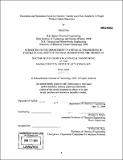Theoretical and simulation tools for electron transfer and chain reactions in single walled carbon nanotubes
Author(s)
Nair, Nitish
DownloadFull printable version (68.29Mb)
Other Contributors
Massachusetts Institute of Technology. Dept. of Chemical Engineering.
Advisor
Michael S. Strano.
Terms of use
Metadata
Show full item recordAbstract
Single walled carbon nanotubes (SWNT) are cylindrical sheets of graphene whose electronic structures and diameters are determined by their chiralities. Current synthetic methods produce batches of nanotubes containing a variety of electronic properties. The separation of these mixtures into semiconductors and metals will greatly enhance their utility for nanoelectronic devices. Progress has been achieved in this area at the laboratory scale through chemical and density-based handles for viable separation. While pristine SWNT of a certain electronic type are in great demand, nanotubes functionalised with specific molecules have applications in the detection of biological analytes, gas sensing and nanoenergetics. An ongoing area of interest is the concept of nanostructure-guided chain reactions, wherein the superior thermal conductivity of a nanotube is used to anisotropically enhance the combustion velocity of the energetic moiety covalently attached to its sidewall. A molecular assembly with this property has the potential to act as a nanoscale thruster and a possible source of pulsed power. This thesis therefore tackles the two research problems stated above: (a) Understand the separation of metallic/semiconducting nanotubes from a modelling perspective to gauge the phenomena from a molecular standpoint; (b) Develop a simple coarse-grained model that describes the characteristics of one-dimensional nanoenergetic materials and extracts the properties of the thermally propagated reaction wave. (cont.) The chemical route of metal/semiconductor separation involves the preferential reaction of a diazonium salt (4-hydroxybenzenediazonium tetrafluoroborate) with metallic nanotubes. Previous experimental work has identified electron transfer from the nanotube to the diazonium molecule as the source of this selectivity. We have used this insight to develop a rate model that extracts rate constants from photoabsorption spectra. This necessitated the deconvolution of the UV-vis-nIR absorption spectra of single-walled carbon nanotubes, recorded subsequent to the reactions, into individual contributions - a complicated procedure because nanotube transition energies are closely spaced. An algorithm has been presented in this work to convert spectral data to diazonium surface coverage on representative SWNT, which were then fitted using adsorption/reaction-based rate equations. The selective reaction of a metallic nanotube with diazonium causes an increase in the density of the latter, which can be harnessed to separate it from the unreacted - and hence, less dense - semiconductors via ultracentrifugation. It is already possible to use a centrifugal field to sort surfactant-suspended carbon nanotubes by diameter in a density gradient. Through a hydrodynamic model, we seek to understand the effects of surfactant adsorption, diazonium reaction and cylindrical geometry on the density of a single walled carbon nanotube. In order to study the propagation of energetic reactions in a nanotube scaffold, we have modelled the latter by a one-dimensional chain of oscillators. (cont.) The characteristics of thermally initiated chain reactions - e.g., wave velocity and modes of propagation- will be explored with a simple molecular dynamics model in conjunction with a Monte Carlo kernel that simulates the stochastic nature of the system. The contribution of the force field to the properties of the reaction has also been analysed through the use of harmonic and anharmonic interactions between the set of oscillators. This conceptual system helps us in formulating design parameters for the fabrication of actual nanostructures in the laboratory.
Description
Thesis (Ph. D.)--Massachusetts Institute of Technology, Dept. of Chemical Engineering, 2009. Includes bibliographical references (p. 124-130).
Date issued
2009Department
Massachusetts Institute of Technology. Department of Chemical EngineeringPublisher
Massachusetts Institute of Technology
Keywords
Chemical Engineering.